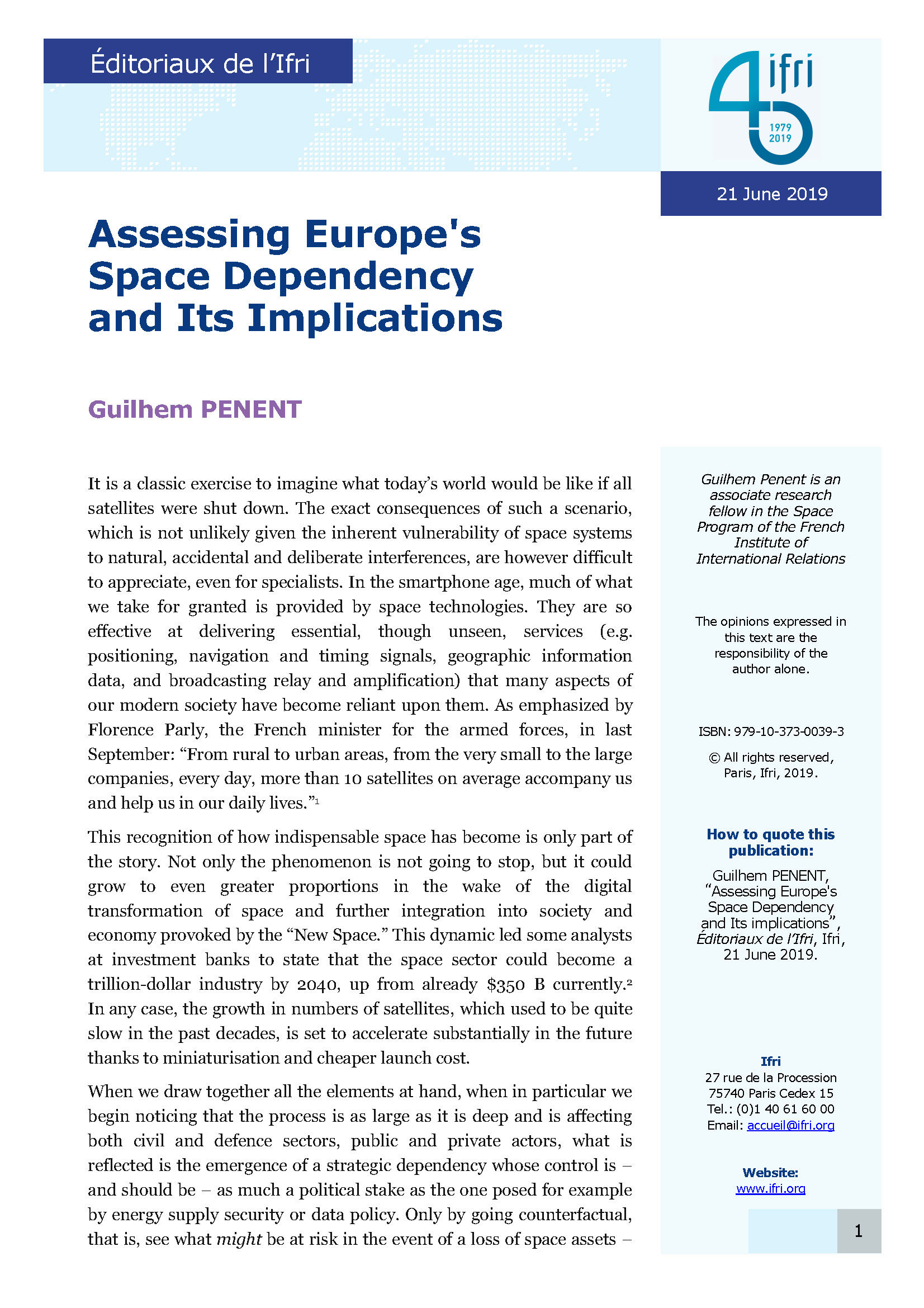Assessing Europe's Space Dependency and Its Implications

It is a classic exercise to imagine what today’s world would be like if all satellites were shut down. The exact consequences of such a scenario, which is not unlikely given the inherent vulnerability of space systems to natural, accidental and deliberate interferences, are however difficult to appreciate, even for specialists.

In the smartphone age, much of what we take for granted is provided by space technologies. They are so effective at delivering essential, though unseen, services (e.g. positioning, navigation and timing signals, geographic information data, and broadcasting relay and amplification) that many aspects of our modern society have become reliant upon them. As emphasized by Florence Parly, the French minister for the armed forces, in last September: “From rural to urban areas, from the very small to the large companies, every day, more than 10 satellites on average accompany us and help us in our daily lives.”[1]
This recognition of how indispensable space has become is only part of the story. Not only the phenomenon is not going to stop, but it could grow to even greater proportions in the wake of the digital transformation of space and further integration into society and economy provoked by the “New Space.” This dynamic led some analysts at investment banks to state that the space sector could become a trillion-dollar industry by 2040, up from already $350 B currently.[2] In any case, the growth in numbers of satellites, which used to be quite slow in the past decades, is set to accelerate substantially in the future thanks to miniaturisation and cheaper launch cost.
When we draw together all the elements at hand, when in particular we begin noticing that the process is as large as it is deep and is affecting both civil and defence sectors, public and private actors, what is reflected is the emergence of a strategic dependency whose control is – and should be – as much a political stake as the one posed for example by energy supply security or data policy. Only by going counterfactual, that is, see what might be at risk in the event of a loss of space assets – regardless of its cause and duration –, could we attempt to grasp this reality and the true meaning of the lesson it conveys for Europe.
A few words of caution
Spacefaring nations often justify their investments in space by the positive general impact, both tangible and intangible, they bring on society, be it at the scientific, technological, industrial, political or security level. This being said, the specific contributions of space development and exploitation by the actors making up Europe and resulting in the dependency of the latter toward orbital systems are difficult to isolate. Studies exist, but have shown somewhat limited ambitions, mainly focusing their efforts on some economic cost/benefits measurements.[3] Simply put, it is not possible to identify what are precisely, quantitatively and exhaustively, the benefits to the European socio-economic fabric and national and collective security brought by space assets. As Einstein pointed out: “Not everything that counts, can be counted.”
A main reason is that we don’t know where space actually begins. Technology-wise, the overlap between aerospace and stricto sensu space could pose a significant challenge as new activities and applications permeating both air and space domains (micro-launchers, high altitude unmanned aircrafts, suborbital tourism, microgravity experiments) are looming. We don’t know where space ends either. Usually, space is presented as a long and complex value-added chain comprising two main inter-connected sectors. On the one hand, the traditional upstream sector concerns itself with the development and provision of space technology and systems. It includes all the actors and activities associated with the launch of systems into space (manufacturing). On the other hand, the more recent but larger and growing downstream sector focuses on the services that exploit space technology (applications). However, mapping the two has been a rather challenging process. Estimates vary widely depending on the scope (definition of ground equipment, satellite operators and final users and relevance of the “downstream of the downstream sector”) as well as methodologies used.
By way of illustration, Eurospace, the European space trade organization, which relies on a narrow definition (manufacturing industry) justified by Europe’s historic technology-focused public investment, estimated that some 40,419 persons work in the European space sector and that sales are worth €8.24 B in 2016, on which France represented respectively around 36% of all jobs and 54% of the corresponding turnover.[4] By contrast, the 2018 business survey of the UK Space Agency uses a broader definition of the space economy (upstream and downstream activities). It found that 41,900 people are employed in space-related activities, generating a turnover of £14.8 B.[5] As for the European Commission (EC), based on different calculus, it estimates that, on aggregate (including public administrations, manufacturing industry, suppliers and the services sector, mainly telecommunications and navigation), the European space economy employs over 230,000 professionals and stands between €45 and 54 B, constituting around one-fourth of the value of the global space sector.[6]
Space dependency in context
As a result, dependency cannot be assessed in absolute, but should be contextualized within a “dependency chain,” where loss of the initial input leads to a cascading effect, affecting the output of the next nearby activities.[7] Space dependency then materializes through impacts of various degrees of severity across different actors and sectors along the chain. Hence, the previously mentioned figures emerging from the upstream sector, although not impressive in themselves compared with other sectors of activity, play a direct role in the capacity of the downstream sector to produce and develop further space-based services, which in turn, indirectly, help generate both safety as well as efficiency and productivity gains and cost avoidances in many non-space governmental, business and even particular users’ activities. Like a pebble thrown into the water, the impact of space assets unavailability thus creates its own ripple effect on the whole of the European economy and society. As an indicator, the EC considers that around 14 million jobs are affected by space systems in one way or another. Within this, in the range of 500,000 and a million will be directly at risk in the event of a loss of all space systems, accounting for around 6% of the total European GDP.[8]
Examined carefully, the impact applies of course differently according to the particular adoption rate and penetration potential of space applications across economy and society. Agriculture, fishing, energy, urban development and land/maritime/air transport are particularly exposed. In most cases, however, for instance in insurance and finance (space-enabled timing for networks synchronisation) or security and defence (C2 and surveillance assets), the dependency appears to be subtler, and therefore perhaps even more critical, in the way that space can be considered as an enabler more than a direct contributor. Indeed, besides their common point which is to collect and transmit “information” simultaneously from one point to many points on Earth irrespective of political borders, a lot depends also on the specificities particular to each of the three main domains of satellite services, i.e. Earth observation, telecommunications and navigation.
In that regard, the existence of credible alternatives is key. Even if some air and land complements can be envisaged, weather and climate change monitoring for example would not be possible without space systems, and above all EO satellites, a great number of which belongs to European actors and can be used for various other dual-use purposes. Similarly, even though dependency to the satellite telecommunications sector is limited thanks to the particularly good coverage of Europe by terrestrial networks, it remains critical in remote locations and to maintain sovereign communication lines given its unmatched level of availability, coverage, confidentiality and resilience. Moreover, as a mature self-supporting commercial market and because of the existence of major world-class providers in Europe, satcom applications are also a huge supporter of the European space sector further upstream, from satellite manufacturing to launching services. The picture is more mixed concerning satellite navigation. While it is the prevalent technology for deriving time and position in our society, there is still a strong reliance on third countries systems, notably the US-controlled GPS which stands as the main constellation currently operational (100% of all receivers and applications in the world are compatible with GPS signals). The situation will obviously be different when Europe’s own Galileo system will be fully deployed and integrated.
The next logical step
Space reliance should nonetheless be considered as a positive sign. It is after all the result of a slow but steady movement initiated 50 years ago when, in the aftermath of Sputnik, Europe asked itself how to remain master of its own destiny and not merely a spectator of the great endeavours of others. Indeed, be it telecommunications, launchers, navigation or even military technology, Europe’s experience in the domain of space has been characterized by the pursuit of “autonomy,” meaning the notion that there could be no Europe in space worth the effort without a capability to access and exploit space freely as an indispensable minimum required for a true space policy to emerge. Investments have led to many successes, such as the Ariane family, as demonstrated by Arianespace’s still impressive market share, or the European Space Agency, whose science and engineering backbone have pushed the technological envelope well beyond what was initially imagined. Although collectively European actors spend six times less than the US government (still as of today – and by very far – the dominant space actor), they compare very favourably with regard to the programs of other space powers, notably in the civil and commercial domain.
This being said, autonomy is a relative concept. In the case of Europe, this indisputable reality has resulted in three major implications: 1/ Europeans being left for lack of means with no choice but to follow the actions of the leader (often the US), choosing among these which one should be emulated and which one should be set aside has been crucial, even more so since space is an ongoing capital-intensive challenge and must be regularly reinvested; 2/ similarly, the strategy adopted has been to secure, at a low cost, but at the risk of an increased dependency on the outside commercial market, a significant business volume to remedy the structural deficiencies of the European institutional market, while helping maintain high performance and reliability for the remaining needs; 3/ last but not least, the emphasis has been put on cooperation to overcome the weakness that a divided Europe into various but limited national programs would necessarily be synonymous with, by unifying most of the resources and expertise available.
The time may have come to question and possibly adapt to the challenges of the 21st century this particular way of doing space. If indeed space dependency is to be seen less as a vulnerability, that could be harmful but could still be mitigated (through increased awareness, resilience and redundancy), than as a proof of maturity, then concrete and ambitious actions must be taken to signal Europe’s determination to remain a space power over the long term. Consistency is key. Although priority should go to ensuring that Europe continues building and upgrading its space infrastructures to sustain and maximize space benefits, while reducing dependency from third countries and lessening reliance on unpredictable export markets, those are no longer sufficient. In today’s much denser and contested space environment, what is needed above all is ensuring the safety and security of one’s assets. Investing in the ability to monitor space, currently an activity on which Europe relies a lot on US data, is a prerequisite. It implies two aspects: 1/ the first one, civil, is related to the need to follow objects and prevent the growing risks of collision with space debris, as well as to have space weather predictions (geomagnetic storms); 2/ the other, military in nature, deals with the detection and attribution of events and possible crisis situations in space. Both are vital to be able to keep a watch over our own satellites which, like others, are expensive and quite fragile.
Seen in this context, the challenge of space surveillance could very well be a defining moment for European strategic autonomy. Not only does it stand as the next logical step, a testimony that Europe has successfully acquired all the core technologies and know-how making it one of the world’s leading space actors, it also represents the most promising area to relaunch cooperation, which has been historically lacking in the domain of defence and security. But most of all, it is the pillar guarantying all of the above, the strategic requirement that would signal how serious Europeans are about their commitment and responsibility towards the sustainable and shared development of space. As stated by Florence Parly in the speech already quoted: “Protecting space […] means protecting our way of life, our willingness to act and to undertake. It means guaranteeing our freedom and ensuring that we will never look away from the sky, where our future is being invented.”
[1]. “Déclaration de Mme Florence Parly, ministre des Armées, sur la défense spatiale”, Toulouse, 7 September 2018, available at: http://discours.vie-publique.fr.
[2]. “Space: Investing in the High Frontier”, MorganStanley.com, 7 November 2018, available at: www.morganstanley.com.
[3]. OECD Handbook on Measuring the Space Economy, OECD, 2012.
[4]. The State of the European Space Industry in 2016, ASD-Eurospace, June 2017.
[5]. Size & Health of the UK Space Industry 2018, UK Space Agency, January 2019.
[6]. Socioeconomic Impacts from Space Activities in the EU in 2015 and Beyond, Brussels, European Commission/PwC, June 2016.
[7]. Dependence of the European Economy on Space Infrastructures, Brussels, European Commission/PwC, March 2017.
[8]. Ibid.

Available in:
Regions and themes
ISBN / ISSN
Share
Download the full analysis
This page contains only a summary of our work. If you would like to have access to all the information from our research on the subject, you can download the full version in PDF format.
Assessing Europe's Space Dependency and Its Implications
Related centers and programs
Discover our other research centers and programsFind out more
Discover all our analysesArtificial Promises or Real Regulation? Inventing Global AI Governance
The risks inherent to the unregulated use of AI, a key technology and vector of profound transformations within societies underline the pressing need to harmonize governance efforts at the international level. The Summit for Action on Artificial Intelligence to be held in Paris in mid-February could be an unprecedented timely occasion to agree on a global governance framework of AI for the public good.
AI, Data Centers and Energy Demand: Reassessing and Exploring the Trends
The information and communication technologies sector today accounts for 9% of global electricity consumption, data centers for 1-1.3%, and artificial intelligence (AI) for less than 0.2%. The growing energy demands of cloud services first, and now AI workloads (10% of today’s data centers electricity demand), have exacerbated this trend. In the future, hyperscale data centers will gain shares amongst all kinds of data centers and AI will probably account for around 20% of data centers electricity demand by 2030.
From nonproliferation to strategic competition: US export controls and China
Technological competition is at the heart of the renewed great-power competition that has characterized relations between the USA and China since the 2010s. The role of technological innovation in the evolution of power relations is already recognized in the literature of international relations. However, developments in US technology policy under the last two administrations raise the reverse question: how does the perception of changing power relations (in this case, Chinese technological catch-up perceived as a threat to US leadership) transform policies granting or denying access to technological innovation?
China’s Mature Node Overcapacity: Unfounded Fears
China is decoupling from, not flooding, the global mature-node semiconductor market. As China increasingly pursues industrial policies encouraging domestic chip production, its own growing chip demand will prevent a direct flood of cheap Chinese chips on foreign shores. However, as Beijing achieves its goal of decreasing the reliance of domestic downstream manufacturers on foreign chips, European and American mature-node semiconductor companies will feel the ripple effects of an increasingly “involuted” Chinese chip ecosystem.








